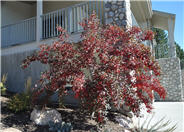
Common name:Purpleleaf Sandcherry
Botanical name:Prunus x cistena
Purpleleaf sandcherry is a deciduous shrub valued for its reddish-purple foliage, fragrant white and pink spring flowers, and purple-black fruit. It grows about 7 to 10 feet tall and 5 to 8 feet wide, with an upright, vase shape. It is sometimes sold as a single-stem tree, but will require maintenance to maintain this form. Bark is a dark brown to red, and is a nice contrast in the winter garden. Branches are nice in vases.
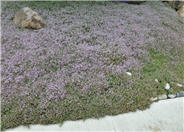
Common name:Reiter Creeping Thyme
Botanical name:Thymus 'Victor Reiter'
Reiter thyme is a tough, vigorous groundcover. Forms dense mats that can tolerate foot traffic and choke out most weeds. It grows to 3 inches tall and spreads 30 inches. Rich, olive green foliage is topped with lavender flowers in mid-summer. Faded flowers can be removed using a lawn mower. It has a pleasant, minty fragrance when crushed, though not considered for culinary uses. Attracts bees and butterflies.
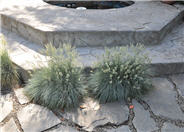
Common name:Elijah Blue Fescue
Botanical name:Festuca cinerea 'Elijah Blue'
The icy-blue coloration of this little grass makes it a stand-out in the garden. Its evergreen, clumping habit make it well suited for edging borders, mass planting, or ground cover. Grows in full sun to part shade. Generally under 12 inches, even in flower. Soft tufts of greenish white flowers emerge in early summer and turn tawny by summers end. Excellent for parkstrips.
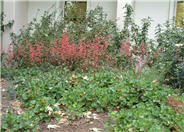
Common name:Coral Bells
Botanical name:Heuchera sanguinea
Coral Bells have beautiful round, scalloped leaves that makes this plant a garden favorite even when it isn't in bloom. Red to carmine bell-shaped flowers appear on a long, graceful, wiry stem in late spring. Removing the spent flowers will prolong the bloom season. Excellent for dry shade areas, they will require more water with more light. Many species and selections are available with different leave and flower colors; also with differing water tolerances. For best effect, plant many together, as they are delicate in appearance and can get lost among bolder plants.
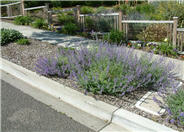
Common name:Catmint
Botanical name:Nepeta x faassenii
Catmint makes soft, grey-green, rounded mounds from 10 to 24 inches high, depending on variety. Most will be wider than tall. This perennial has lavender blue flowers from late spring to early summer, though if you shear off the first flowers, it will frequently bloom again later in the summer. Different varieties have slightly different bloom times. Leaves are attractive, crinkled blue-grey and are aromatic.
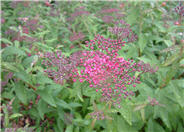
Common name:Little Princess Spirea
Botanical name:Spiraea japonica 'Little Princess'
'Little Princess' spirea is a tidy mounding shrub growing about 3 feet tall but up to 6 feet wide. It has small, finely texture leaves of mint green that turn a pleasing yellow in the fall. Clusters of tiny pink flowers bloom from June to August. Use in a perennial, shrub, or foundation border; its small scale makes it nice in front of taller shrubs. Attracts butterflies.
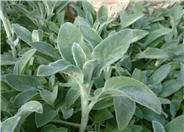
Common name:Lambs' Ear
Botanical name:Stachys byzantina
Lambs' ear is a most fabulous perennial and groundcover, grown primarily for its soft, velvety leaves. It grows about a foot or so tall and spreads 2 to 3 feet. Leaves are grey-green and hairy, with the hairs giving the leaves a silvery cast. Though not really evergreen, the leaves turn a lovely buff come fall and persist well into the winter months, until buried under snow. Erect flowering stems arise May and June, with pink to lavender flowers at the terminal end. Some remove the flower stems before they bloom, but they are simple and charming. Use as a edging plant for a perennial, shrub, or foundation border, or as a ground cover. There are some named cultivars; 'Helene Von Stein' and 'Big Wave' claim to be flowerless, though in my experience they all eventually come to flower. Leaves are wonderful on wreaths (but you'll need a glue gun). There are lambs ear planted at the Washington Square Demonstration Garden.
| Designer: Xeriscape Design | Stone and Step 8 |
Photographer: GardenSoft |
Water Saving Tip:
Water-wise plants can be beautiful as well as practical.
Take your 'My List' Hydrozone Report to a landscape designer, or local nursery, when selecting and purchasing plants.
